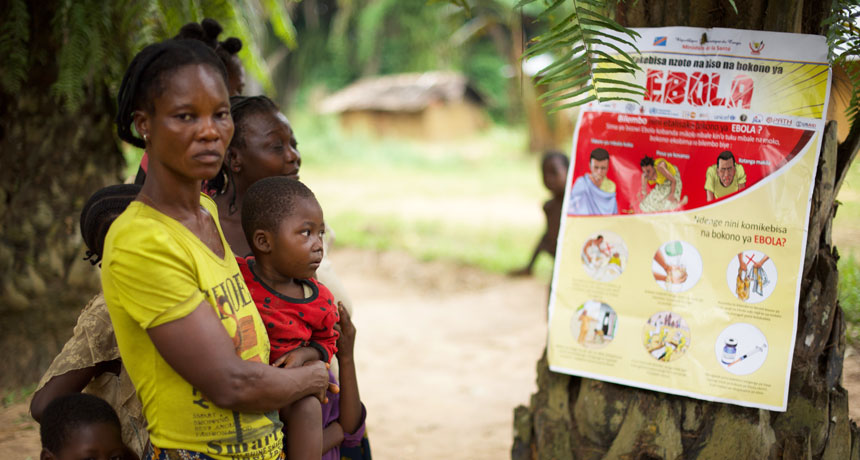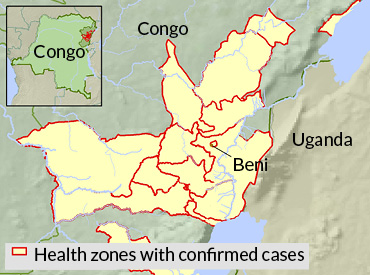Congo’s Ebola outbreak is a testing ground for new treatments
The four different drugs include three antibody treatments and one antiviral

COMMUNITY OUTREACH In Congo, public health efforts against Ebola include posters with information on stopping the spread of the disease. Officials are also testing experimental therapies to treat Ebola during the current outbreak.
Lianne Gutcher/WHO
Amid the second largest Ebola outbreak ever, the hunt for a lifesaving treatment is on. A clinical trial of patients taking place now in Congo is gathering evidence on experimental therapies, to provide a proven option when the deadly virus inevitably emerges again.
The first multidrug clinical trial of Ebola therapies, which began enrolling patients in November, will compare the effectiveness of three different antibody treatments and one antiviral drug. One therapy tested briefly during the 2014–2016 outbreak in West Africa, the largest ever, has already shown promise.
With the trial data, though, “we’ll be able to say, ideally, that this drug or that drug actually does work, not just we think or hope it does work,” says Richard Davey, one of the principal trial investigators and the deputy clinical director at the U.S. National Institute of Allergy and Infectious Diseases in Bethesda, Md.
Ebola virus causes severe illness, including fever, vomiting, diarrhea and bleeding. Death rates range from 25 to 90 percent, depending on the outbreak. During Congo’s current outbreak — the country’s 10th and its largest since Ebola was discovered within its borders in 1976 — about 63 percent of those infected have died, or 510 out of the 811 cases reported as of February 9. Stopping the outbreak, which began August 1, has been difficult due to security risks and armed conflict in the region, as well as public mistrust of the medical response, the World Health Organization says.
The drug trial began at a treatment unit in the northeastern Congolese city of Beni, with plans to add additional units. Enrolled patients will receive one of the four trial therapies, as well as standard, supportive care including fluids, electrolytes and painkillers. Researchers will compare death rates between each group of enrolled patients after 28 days of treatment to determine each drug’s effectiveness. All four treatments on trial have been studied in animals. The three antibody treatments have been deemed safe for human use, while safety testing of the antiviral in people is under way.
The antibody treatments “basically jump-start the immune system to have an immediate presence of antibodies directed against the virus,” Davey says. One, called mAb114, was cloned from a sample taken from an Ebola survivor 11 years after the person’s infection in 1995. This treatment targets a protein on the surface of the Ebola virus and somehow hampers the virus’ entry into cells. All macaques given a lethal dose of Ebola and treated with mAb114 survived even when the drug was administered five days after infection, researchers reported in Science in 2016.
While mAb114 is comprised of a single antibody, two others — REGN-EB3 and ZMapp — are cocktails, each containing three different antibodies. In a study that evaluated different doses of REGN-EB3, certain dosing regimes prevented death in all or most macaques that had been infected with Ebola, according to a 2018 study published in the Journal of Infectious Diseases.
Meanwhile, ZMapp appeared to benefit some patients in a clinical trial conducted at the end of the outbreak in West Africa. Eight of 36 patients receiving the drug and supportive care died, compared with 13 of 35 patients who received only supportive care, researchers reported in the New England Journal of Medicine in 2016. But that earlier trial work didn’t have enough patients to provide statistically significant evidence that the drug works better than supportive care alone.
The only non-antibody treatment being studied in the trial is an antiviral drug called remdesivir, or GS-5734, which appears to target a step in the virus’ “owner’s manual” for making copies of itself. The drug suppressed virus replication, and, in certain doses, helped Ebola-infected macaques survive, researchers reported in Nature in 2016.
All of the therapies under scrutiny are already being used in this outbreak under “compassionate use” protocols set by WHO. In the Congolese treatment units that will participate in the clinical trial, patients will be randomly assigned to receive one of the drugs, with an equal number of patients in each group. If the trial doesn’t enroll enough patients to get statistically significant results, it will remain open to patients in future outbreaks.
Meantime, people not yet exposed to Ebola but considered high risk in Congo and surrounding countries are receiving an experimental vaccine called rVSV-ZEBOV (SN Online: 5/21/18) to prevent infection. More than 73,000 people have gotten the preventative shot so far. Congo has vaccinated health workers, patients’ family members and other contacts. Neighboring regions in Uganda and South Sudan are also vaccinating health workers and others at risk. Rwanda has plans to follow suit.
“The one silver lining in the entire dark cloud” of this outbreak is the availability of the vaccine and the therapeutics, says infectious disease epidemiologist Mosoka Fallah of the National Public Health Institute of Liberia in Monrovia. He thinks the deployment of the vaccine and the treatments have kept the outbreak from becoming far worse than it already is.
“As much as it is a bleak situation, it is hopeful,” Fallah says.








